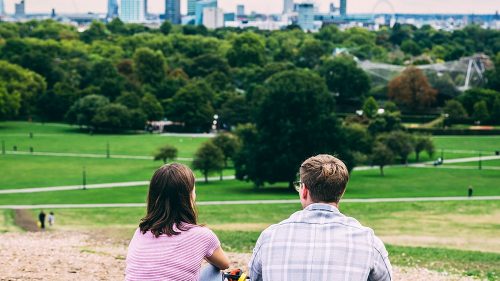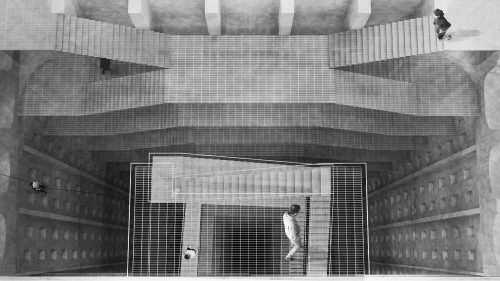Since its inception, the urban planning profession has brought about many social advancements and some of the policies and techniques developed have had major positive impacts. For instance, in the UK, green belt policy has curbed uncontrolled urban sprawl. The preference shown to town and city centres and ‘brownfield’ land has helped create compact urban centres that prioritise walking and cycling ahead of the car. Effective policy has also ensured that special areas of natural beauty and of historic significance are well protected.
Good urban planning has always been about finding balance and often the focus has been around creating better health outcomes. In the UK, much of this can be traced back to the UK’s Garden Cities movement of the late 1800s.
A Crowded and Anxious Future?
In recent years we have come to understand in more depth that the way we plan and design our built environments can support people’s physical and mental health. However, the world is changing at an exponential rate and this is in large part because of rapid urbanisation and the proliferation of technologies.
According to the United Nations, more than half of the world’s population now lives in urban areas and this is likely to grow to 66% by 20501.
The proliferation of smart technologies is just as dramatic. According to Statista, the number of smartphone users worldwide is over three billion and this could grow closer to four billion by 20212.
Urbanisation, and the densification that often follows, outstrip the ability of a place to provide the necessary infrastructure, often resulting in cramped and polluted places that can trigger health problems.
According to the Centre for Urban Design and Mental Health, “cities are associated with higher rates of most mental health problems compared to rural areas: an almost 40% higher risk of depression, over 20% more anxiety, and double the risk of schizophrenia, in addition to more loneliness, isolation and stress”3.
Anxiety can also be triggered by technology, particularly the overuse of social media. The Anxiety and Depression Association of America highlights research which identifies that “using social media obsessively causes more than just anxiety. In fact, testing has found that using too much internet can cause depression, attention deficit hyperactivity disorder (ADHD), impulsive disorder, problems with mental functioning, paranoia, and loneliness”4.
The coincidence of urbanisation and technification, and the resultant health challenges, are therefore unique to this period in human history. As a result, there is a pressing need for urban planning to evolve once more to address this. Below are three specific challenges not regularly included in planning discussion that might benefit closer review.
- Permanently activated
We have become adept at creating tight urban places that are generally taller, denser and more mixed. We have created places that are teeming with things to see and do, which are ‘activated’ throughout the day and night. In fact, ‘activation’ is seen as a key requirement of most urban situations.
This emphasis on activation has occurred in tandem with our growing attachment to our smart devices and, considering these trends, are we doing enough to ensure that there are places and spaces for people to disconnect and ‘deactivate’ their often-over-stimulated brains? Are we creating buildings that provide opportunities to rest and recuperate? Are we planning for the mind, body and soul?
In a world where our minds are almost permanently over-stimulated, not least by our portable smart devices, it is becoming almost impossible to be ‘off-line’ and ‘present’.
- Indoors and Isolated
A compounding challenge is that, for the first time in human history, we are spending most of our lives indoors. According to a survey published by the Lawrence Berkeley National Laboratory, Americans spend on average 90% of their time indoors5. For most of us, time is now divided between bed, transportation, desk, eatery, shopping, indoor leisure, gym and other indoor behaviours.
Living an indoor life is a concern for many reasons, not least because people are missing out on fresh air and natural daylight. Under the influence of central heating and in the absence of drafts, cleaning fluids, paint solvents and furniture fumes can create a toxic mix of VOCs inside our homes and workplaces.
There are other potential health problems linked to spending too much time indoors. Vitamin D is essential for good health and wellbeing, but for it to be produced, we need exposure to UVB rays, i.e. we must spend time outdoors. In a recent article for the New Scientist, Linda Geddes argues that many people aren’t storing enough vitamin D to see them through the winter and there is increasing evidence that bones, muscles and other tissues suffer as a result. Geddes also highlights the specific benefits of exposure to morning and afternoon light; it helps strengthen our circadian rhythms. She stresses that “the Ancient Babylonians, Egyptians, Greeks and Romans all recognised that sunlight could be harnessed to promote health, something which science now recognises“6.
A further impact of our increasingly indoor lives is the reduction in opportunities for meaningful interaction in the community. Levels of urban loneliness is on the rise. According to a poll on loneliness undertaken by ComRes for the BBC in 2013, 52% percent of London’s residents feel lonely7. Loneliness is very common in post-industrial developed economies around the globe and it has a significant impact on health and wellbeing.
- Our buildings can make us sick
A third compounding challenge is that in much the same way that our buildings can boost our health and well-being, they can also make us sick. According to the UK’s National Health Service, ‘”sick building syndrome is most common in open-plan offices, but you can get it in any building” and is probably a result of a combination of things, including poor ventilation, internal air pollutants and poor unnatural lighting8.
We need psychologically, not just biologically, healthy buildings. Neuroscience is being used to look inside the minds of a buildings inhabitants and establish how people experience them. Based on real data which more accurately ‘maps’ how places make us feel then surely there is a greater prospect of us designing healthy places.
Planning and design must evolve
In the light of these challenges, we need to positively plan for ‘deactivation’ as well as ‘activation’ as people need help with disconnecting and quietening their busy mind. As Eckhart Tolle, author of The Power of Now9 has suggested, we need a better balance between ‘being’ and ‘doing’. Furthermore, and wherever possible, this needs to be outdoors or in buildings that are specially designed to boost our health and well-being.
To achieve this, we need a new approach when planning for conscious cities.
Biophilic design
Whilst it is not the only way, biophilic design is an important foundation for planning conscious and healthy cities. As described by Oliver Heath, “Biophilia … focuses on human’s innate attraction to nature and natural processes. It suggests that we all have a genetic connection to the natural world built up through hundreds of thousands of years of living in agrarian settings”10. Biophilic design is believed to be able to reduce stress and anxiety and support the bodies healing processes.
Biophilia involves carefully crafting environments where natural light, water and fresh air abound, where the movement of greenery creates a soothing atmosphere, where the inside and the outside merge and where buildings incorporate natural shapes, colours and materials.
Bringing nature into our urban situations can have an incredibly powerful effect on health and well being. The sounds of nature like rustling trees or bird song can cut through mental noise and trigger a healing response. In this moment you become more aware of your surroundings and dial down feelings of anxiety. The natural world can take us out of our heads and deliver us back into the present moment.
Neuro-design
A new wave of neuro-architecture is also emerging. Shape, form and even beauty are thought to affect our emotional states, biology and energy levels. Neuro-aesthetics helps us identify how our environment affects us at a sensory level and stimulates our brain and evokes a biological response. We need to specifically design places as ‘human-rechargers’.
Human-centric planning
However, we now need planning to evolve so that there is an encouraging and supportive super-structure within which a new era of policy, master planning, urban design and architecture can prosper.
As highlighted by the Future Cities Catapult, it is the case that “historically, planners and policy-makers have thought of cities in relation to buildings and infrastructure rather than the people that inhabit them”11. Building on the foundations laid by the Garden City movement, ‘human-centric planning’, informed by neuroscience, feels like the natural next step for those involved in crafting our future towns and cities.
UK planning policy is evolving. For example, the National Planning Policy Framework advises that planning decisions should “enable and support healthier lifestyles, especially where this would address identified health and well-being needs”12. Whilst this is a good start, new, specific, human-centric policies and initiatives are also urgently needed. Such initiatives should work to address the root causes, as well as to provide clear guidance around localised planning and design. We need planning to consider the whole person, mind, body and soul. We need ‘planning for well-beings’.
More specifically, planning should enable and ramp-up the delivery of a range of spaces and buildings:
- specifically designed and located to help us deactivate and recharge;
- that provide strong encouragement to be outdoors; and
- that incorporate the thinking and benefits from biophilia and neuro-design
Positive initiatives are emerging. The introduction of the ‘urban greening factor’ in the new draft London Plan13 is positive and, inspirationally, London was officially made the world’s first National Park City in 201914.
Yet there are huge pressures on those involved in shaping our built environments and delivering what often growing populations need. In London the chronic housing shortage and limited land availability makes the provision of spaces and buildings that are not revenue or income generating very challenging. We need to find mechanisms by which space set aside for outdoor ‘deactivation’, for example, is valued in a commercial sense
So, the economic model needs to be designed to support delivery. Public sector finances are stretched to breaking point meaning direct funding of initiatives is in most cases highly unlikely for the foreseeable future. In a recent report, the Town and Country Planning Association states that during a series of practitioner workshops in 2018, the two top barriers to delivering healthy environments were identified as “competing policy priorities” and “lack of financial resources”15.
Ways to leverage private sector expertise and funding therefore need to be found. One property company that is really embracing this is British Land. In ‘A Design for Life’, a WPI Economics report for British Land, it states that the NHS in England currently spends around £11.6 billion each year on mental health services, and that the wider costs to the economy is estimated to be over £105 billion annually16.
Therefore, if upstream improvements in the way in which we create and manage urban environments could be made, the downstream savings could be enormous. British Land’s suggestion is the creation of ‘Urban Wellbeing Zones’ (UWZs). Like Enterprise Zones, British Land point out that ‘UWZs’ could be used to retain business rates growth in specific areas, leverage tax increment finance and combine this with existing powers to introduce, for example, Business Improvement Districts, to allow investment in infrastructure with direct health benefits.
Married with a more ‘human-centric’ planning system, it is this level of innovation and leadership that can help bring about a new era in the planning and design of our built environment and help create places for ‘well-beings’.
References
- United Nations, World Urbanization Prospects (2014). Retrieved from: https://www.un.org/en/development/desa/news/population/world-urbanization-prospects-2014.html
- Statista, Number of smartphone users worldwide (2019). Retrieved from: https://www.statista.com/statistics/330695/number-of-smartphone-users-worldwide/
- Centre for Urban Design and Mental Health, How the city affects mental health (n.d.). Retrieved from: https://www.urbandesignmentalhealth.com/how-the-city-affects-mental-health.html
- The Anxiety and Depression Association of America, Social Media Obsession (2018). Retrieved from: https://adaa.org/social-media-obsession
- Neil E. Klepeis and others / published by Lawrence Berkeley National Laboratory, The National Human Activity Pattern Survey (NHAPS): A Resource for Assessing Exposure to Environmental Pollutants (2001).
- Linda Geddes, Let the Sun Shine. New Scientist, pp. 28-32 (16 March 2019)
- ComRes for the BBC, BBC Religion Loneliness Study (2013)
- NHS, Sick building syndrome (2017). Retrieved from: https://www.nhs.uk/conditions/Sick-building-syndrome/
- Eckhart Tolle, The Power of Now (Namaste Publishing, 1997)
- Oliver Heath, Biophilic design – connecting with nature to improve health and well-being (n.d.). Retrieved from: https://www.oliverheath.com/biophilic-design-connecting-nature-improve-health-well/
- Future Cities Catapult, Neuroscience Built Environment (2018). Retrieved from: https://futurecities.catapult.org.uk/event/third-thursday-neuroscience-built-environment/
- Ministry of Housing, Communities & Local Government, National Planning Policy Framework (UK, 2012)
- Greater London Authority, Draft New London Plan (2019)
- London National Park City (n.d.). Retrieved from: http://www.nationalparkcity.london/
- Town and Country Planning Association, The state of the union (London, 2019)
- British Land and WPI Economics, A Design for Life (2018)








